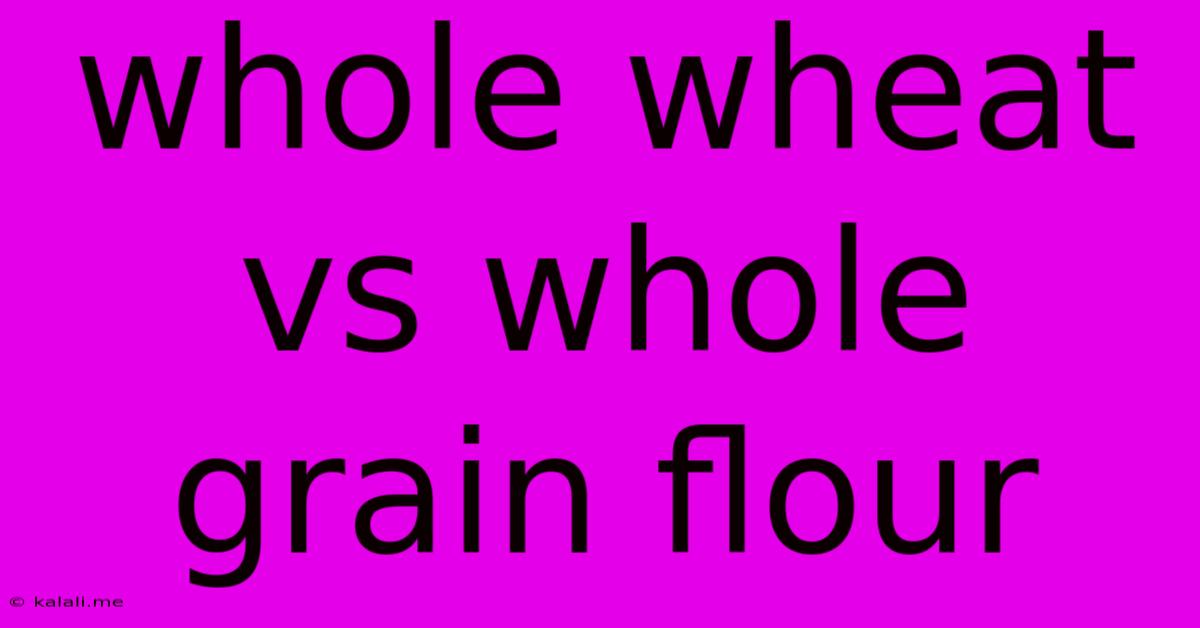Whole Wheat Vs Whole Grain Flour
Kalali
May 20, 2025 · 3 min read

Table of Contents
Whole Wheat vs. Whole Grain Flour: What's the Difference?
Choosing the right flour can significantly impact the nutritional value and texture of your baked goods. While often used interchangeably, whole wheat flour and whole grain flour aren't exactly the same. Understanding their differences can help you make informed choices for a healthier and more delicious baking experience. This article will delve into the specifics of each flour type, highlighting their nutritional profiles, baking characteristics, and best uses. Knowing the distinction between these flours will elevate your baking game and contribute to a more balanced diet.
Understanding Whole Wheat Flour
Whole wheat flour is made by grinding the entire wheat kernel – the bran, germ, and endosperm – into a flour. This process preserves all three parts of the wheat berry, resulting in a flour that's rich in fiber, protein, and essential nutrients. The presence of bran and germ contributes to its distinctive darker color and nuttier flavor compared to refined white flour. This also affects its texture; baked goods made with whole wheat flour tend to be denser and slightly more coarse.
Nutritional Benefits of Whole Wheat Flour:
- High in Fiber: Promotes digestive health and helps regulate blood sugar levels.
- Rich in Protein: Contributes to satiety and muscle building.
- Excellent Source of Vitamins and Minerals: Contains essential nutrients like iron, magnesium, and B vitamins.
- Supports Heart Health: The fiber content can help lower cholesterol levels.
Baking with Whole Wheat Flour:
Whole wheat flour's high fiber content can affect dough development. It often requires more liquid and can result in denser baked goods. Substituting whole wheat flour for all-purpose flour may require adjusting recipes to achieve the desired texture. Consider starting with partial substitutions (e.g., half whole wheat, half all-purpose) to gradually adapt your recipes.
Decoding Whole Grain Flour
The term "whole grain flour" encompasses a broader category. It includes flour made from the entire kernel of various grains, not just wheat. This means it can be made from oats, rye, barley, or other grains. Each whole grain flour will offer a unique nutritional profile and baking characteristics, influenced by the specific grain used. For example, oat flour will have a different taste and texture compared to rye flour.
Nutritional Benefits of Whole Grain Flours:
The benefits are largely similar to those of whole wheat flour, but the specific vitamins and minerals will vary depending on the grain source. All whole grain flours are generally:
- Good sources of fiber: Promoting digestive health and satiety.
- Rich in various vitamins and minerals: Providing a wide range of nutrients.
- Beneficial for overall health: Contributing to cardiovascular health, weight management, and blood sugar control.
Baking with Whole Grain Flours:
Similar to whole wheat flour, whole grain flours often lead to denser baked goods. The exact baking behavior depends heavily on the grain used. Experimentation is key to mastering baking with various whole grain flours. You might need to adjust liquid amounts, leavening agents, and even baking times to achieve optimal results.
Whole Wheat Flour vs. Whole Grain Flour: Key Differences Summarized
| Feature | Whole Wheat Flour | Whole Grain Flour |
|---|---|---|
| Grain Source | Wheat only | Various grains (wheat, oats, rye, etc.) |
| Nutritional Profile | High in fiber, protein, B vitamins, iron | Varies depending on the grain source |
| Texture | Dense, slightly coarse | Dense, texture varies by grain source |
| Flavor | Nutty | Varies depending on the grain source |
Choosing the Right Flour for Your Needs
The best flour for you will depend on your dietary preferences and baking goals. If you're looking for a readily available and versatile option with known nutritional benefits, whole wheat flour is an excellent choice. If you're seeking a wider variety of flavors and textures, exploring different whole grain flours opens a world of culinary possibilities. Remember to gradually incorporate whole grain flours into your recipes to adjust to their unique baking characteristics. Experimentation is key to discovering your favorite combinations and perfecting your baked goods.
Latest Posts
Latest Posts
-
Keep Up With The Good Work
May 21, 2025
-
South Park Stick Of Truth Homeless
May 21, 2025
-
Is Momentum A Scalar Or A Vector
May 21, 2025
-
Can You Use A Dimmer Switch On Led Lights
May 21, 2025
-
One Tick On Whatsapp But Can See Profile Picture
May 21, 2025
Related Post
Thank you for visiting our website which covers about Whole Wheat Vs Whole Grain Flour . We hope the information provided has been useful to you. Feel free to contact us if you have any questions or need further assistance. See you next time and don't miss to bookmark.